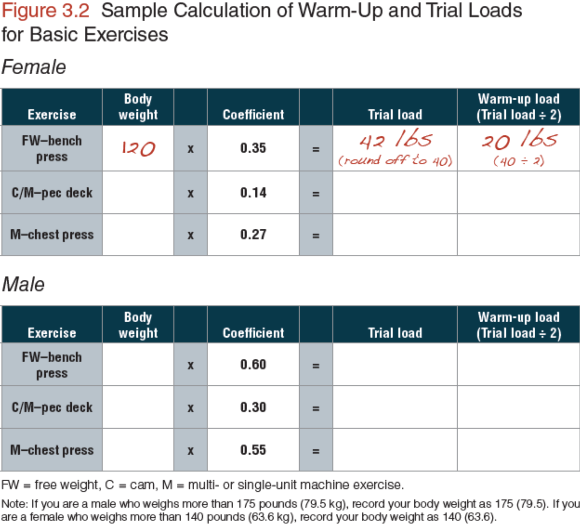Determine warm-up and trial loads
This is an excerpt from Weight Training-5th Edition by Thomas R Baechle,Roger W Earle.
This practice procedure explains how to use the formulas shown in figure 3.2 to determine the warm-up and trial loads for the basic exercises. If you select one of the first three exercises listed in steps 4 through 9, you will need to identify the coefficient (a number that represents a certain percent of the person's body weight) associated with that exercise to determine warm-up and trial loads. Each step includes exercises and coefficients that are specific to a certain muscle group. The example provided in figure 3.2 is associated with the chest muscle area from step 4. Realize that using the coefficients results in an estimated warm-up or trial load. Individual differences, combined with the variation in equipment design, make it difficult, if not impossible, to derive coefficients that are without error. Those presented in this text are starting points for determining appropriate loads. If there is a need to convert pounds to kilograms or kilograms to pounds, refer to the conversion chart in the back of the book.
You will notice that for the first three exercises, the letters FW (for free weight), C (for cam), and M (for multi-unit machine—but it can apply to a single-unit machine too) identify the type of equipment that is used when performing them.
After you've located the name of the exercise you've selected, write your body weight in the appropriate space and multiply it by the number to the right of it (the coefficient). The coefficient is a number that has been derived from studies of males and females who, for the most part, do not have experience in weight training. When multiplied by your body weight, the coefficient can be used to estimate training loads, and using one-half of it provides an appropriate warm-up load. The use of body weight in determining appropriate loads is based on its relationship to strength. This is the same logic used for creating weight divisions in sports such as wrestling, boxing, and weightlifting.
Note that if you are a male who weighs more than 175 pounds (79.5 kg), you should record your body weight as 175 pounds (79.5 kg). If you are a female who weighs more than 140 pounds (63.6 kg), record your body weight as 140 pounds (63.6 kg).
To complete this procedure, round the number to the nearest 5-pound (2.3 kg) increment or to the closest weight-stack plate. This becomes your trial load. The example seen in figure 3.2 is of a female who weighs 120 pounds (54.5 kg) and has selected the free-weight bench press from the three chest exercises available. In this example, the rounded-off trial load equals 40 pounds (18.2 kg) and one-half of that equals a warm-up load of 20 pounds (9.1 kg).

SHOP

Get the latest insights with regular newsletters, plus periodic product information and special insider offers.
JOIN NOW


